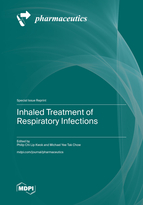Inhaled Treatment of Respiratory Infections
A special issue of Pharmaceutics (ISSN 1999-4923). This special issue belongs to the section "Pharmaceutical Technology, Manufacturing and Devices".
Deadline for manuscript submissions: closed (31 December 2022) | Viewed by 37907
Special Issue Editors
Interests: pulmonary delivery; aerosols; inhalation; particle engineering; formulation; physicochemical characterisation; electrostatics
Special Issues, Collections and Topics in MDPI journals
Interests: bacteriophage; biopharmaceutics; gene delivery; inhalation; particle engineering; pulmonary drug delivery
Special Issues, Collections and Topics in MDPI journals
Special Issue Information
Dear Colleagues,
Respiratory infections are conventionally treated with oral or intravenous antimicrobials (antibiotics, antifungals, antivirals). However, these routes of administration are not ideal because the required drugs are systemically delivered rather than being targeted to the respiratory tract. Higher doses may also be needed to achieve sufficiently high drug concentrations in the lungs, which may consequently cause more adverse effects. On the other hand, the drugs can be delivered efficiently into the airways as inhaled aerosols. Lower doses can then be used to attain relatively high local concentrations. There are specific challenges to the development of inhaled formulations, such as optimising their physicochemical stability and aerosol performance. In addition, antimicrobial resistance is an urgent global public health issue. Novel strategies are required to overcome these problems.
This Special Issue will focus on recent advances in treating respiratory infections with inhaled formulations.
Dr. Philip Chi Lip Kwok
Dr. Michael Chow
Guest Editors
Manuscript Submission Information
Manuscripts should be submitted online at www.mdpi.com by registering and logging in to this website. Once you are registered, click here to go to the submission form. Manuscripts can be submitted until the deadline. All submissions that pass pre-check are peer-reviewed. Accepted papers will be published continuously in the journal (as soon as accepted) and will be listed together on the special issue website. Research articles, review articles as well as short communications are invited. For planned papers, a title and short abstract (about 100 words) can be sent to the Editorial Office for announcement on this website.
Submitted manuscripts should not have been published previously, nor be under consideration for publication elsewhere (except conference proceedings papers). All manuscripts are thoroughly refereed through a single-blind peer-review process. A guide for authors and other relevant information for submission of manuscripts is available on the Instructions for Authors page. Pharmaceutics is an international peer-reviewed open access monthly journal published by MDPI.
Please visit the Instructions for Authors page before submitting a manuscript. The Article Processing Charge (APC) for publication in this open access journal is 2900 CHF (Swiss Francs). Submitted papers should be well formatted and use good English. Authors may use MDPI's English editing service prior to publication or during author revisions.
Keywords
- respiratory infections
- inhalation
- aerosols
- pulmonary drug delivery
- antimicrobials








